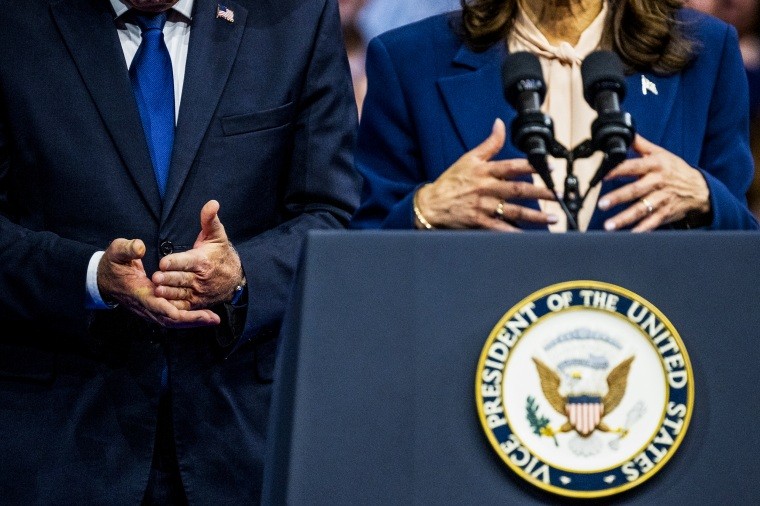While Josh Shapiro, the Pennsylvania Governor celebrated for his sharp legal mind and perceived presidential future, emerged as a prominent contender for Kamala Harris’s Vice President pick, Minnesota Governor Tim Walz ultimately became the favored choice. This decision, as revealed by insiders, hinged less on political star power and more on strategic considerations centered around loyalty, team dynamics, and mitigating potential risks for Harris’s political future.
Shapiro, a figure known for his eloquent communication and ambition, initially garnered significant attention and public support. However, his profile also brought scrutiny, particularly regarding his stance on Israel and criticisms of pro-Palestinian protests. Concerns were raised that selecting Shapiro could inadvertently amplify discussions around the sensitive Gaza issue, a topic the party preferred to avoid bringing “back into the foreground.”
 Vice President Kamala Harris speaks as Minnesota Governor Tim Walz gestures
Vice President Kamala Harris speaks as Minnesota Governor Tim Walz gestures
Vice President Kamala Harris engages in conversation with Minnesota Governor Tim Walz during a campaign event in Philadelphia, highlighting Walz’s collaborative approach.
Beyond the immediate political sensitivities, Harris’s team harbored doubts about Shapiro’s ability to significantly boost their electoral prospects in his home state. Internal polling suggested that Shapiro’s impact might not be substantially greater than other potential candidates. Furthermore, Shapiro’s past, including his support for school vouchers, a sexual harassment claim against a former aide, and a complex legal case from his time as attorney general, presented potential vulnerabilities that could be exploited by political opponents.
Perhaps a more decisive factor in Harris’s calculus was the perceived conflict between Shapiro’s own political ambitions and her needs. The concern that Shapiro’s aspirations could overshadow or even compete with Harris’s was directly communicated to her team, notably by an advisor to Senator John Fetterman, who has had public disagreements with Shapiro. As one senior Democrat with experience working with Shapiro stated, “I would not want to be ahead of Josh Shapiro in the line of succession,” underscoring the apprehension about potential power dynamics.
In contrast to Shapiro’s assertive profile, Tim Walz was perceived as an “affable team player,” rooted in his background in the military and education rather than the cutthroat world of high-stakes politics. This contrast was crucial for Harris, who, given her unique path to nomination and the ever-present possibility of internal dissent or a primary challenge in 2028, prioritized finding a running mate who would be unequivocally supportive and steadfast.
The Harris campaign sought someone who could “prop her up during hard times” and stand firmly by her side amidst the expected onslaught of political attacks, misinformation, and deepfakes anticipated in the upcoming political climate. Walz fit this profile perfectly, seen as someone unlikely to “sabotage” Harris through leaks or behind-the-scenes maneuvering, especially if she were to ascend to the presidency.
Walz’s public defense of President Biden following a challenging meeting with Democratic governors further solidified his image as a loyal and supportive figure within the party. The term “loyal” became a common descriptor for Walz among Biden aides and advisors, emphasizing his commitment to teamwork and party unity. This quality resonated deeply with Harris, who herself served as a “true partner” to President Biden and sought a similar dynamic in her own Vice Presidential selection.
While Harris and Walz had limited prior interactions, their brief encounters, including Harris’s visit to a Planned Parenthood clinic in St. Paul, provided glimpses into Walz’s approach. Harris and her team also observed Walz’s effectiveness on the campaign trail and in media appearances. His sharp and memorable branding of Republican JD Vance as “weird” quickly gained traction within the Democratic party, showcasing Walz’s political acumen and ability to resonate with voters.
Strategists like Caitlin Legacki pointed out the contrasting voter appeal of Shapiro and Walz. While Shapiro might evoke comparisons to a “next Obama,” Walz’s more grounded, Jon Tester-esque persona could appeal to a broader spectrum of voters, including those in suburban, exurban, and potentially even rural areas. Furthermore, for Democrats mindful of voter demographics, particularly concerns about Muslim and Arab voters, Walz’s successful track record in Minnesota, a state with a significant Muslim population, presented an added advantage.
Ultimately, Kamala Harris’s choice of Tim Walz reflects a strategic prioritization of loyalty, team cohesion, and risk mitigation over the potential allure of a high-profile, but potentially more complex, figure like Josh Shapiro. In a turbulent political landscape, Harris opted for a partner who offered stability and unwavering support, qualities deemed paramount for navigating the challenges ahead.
